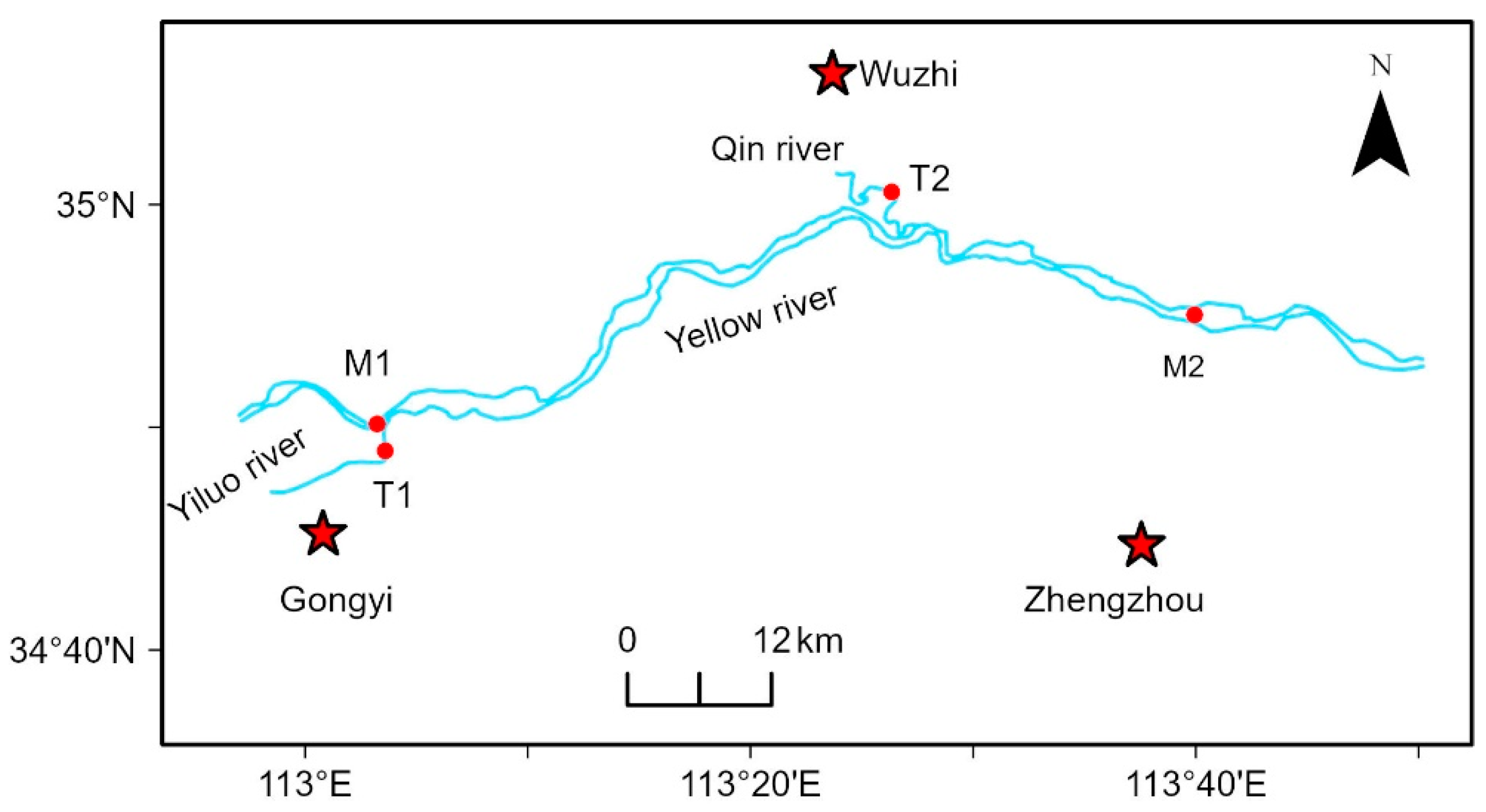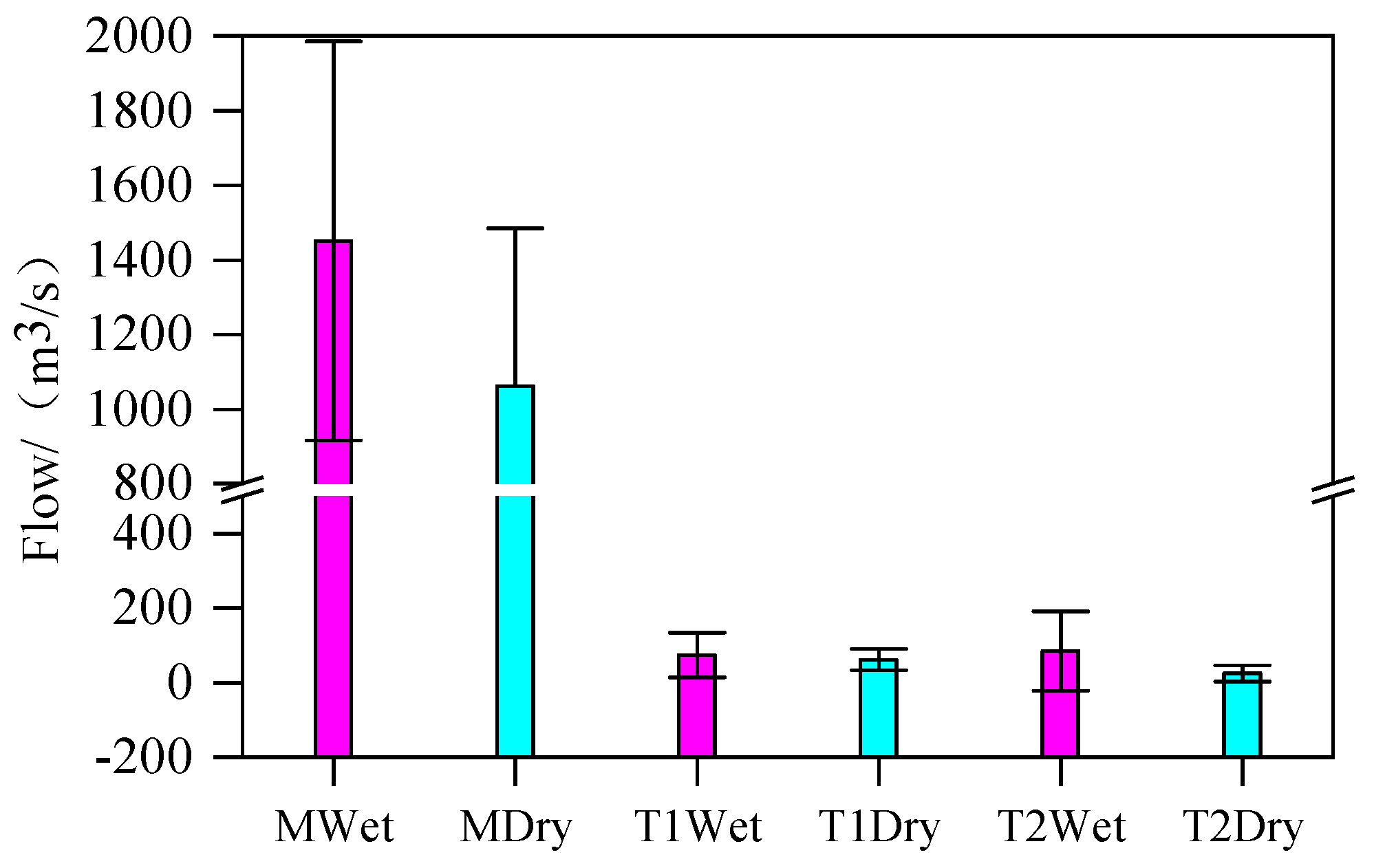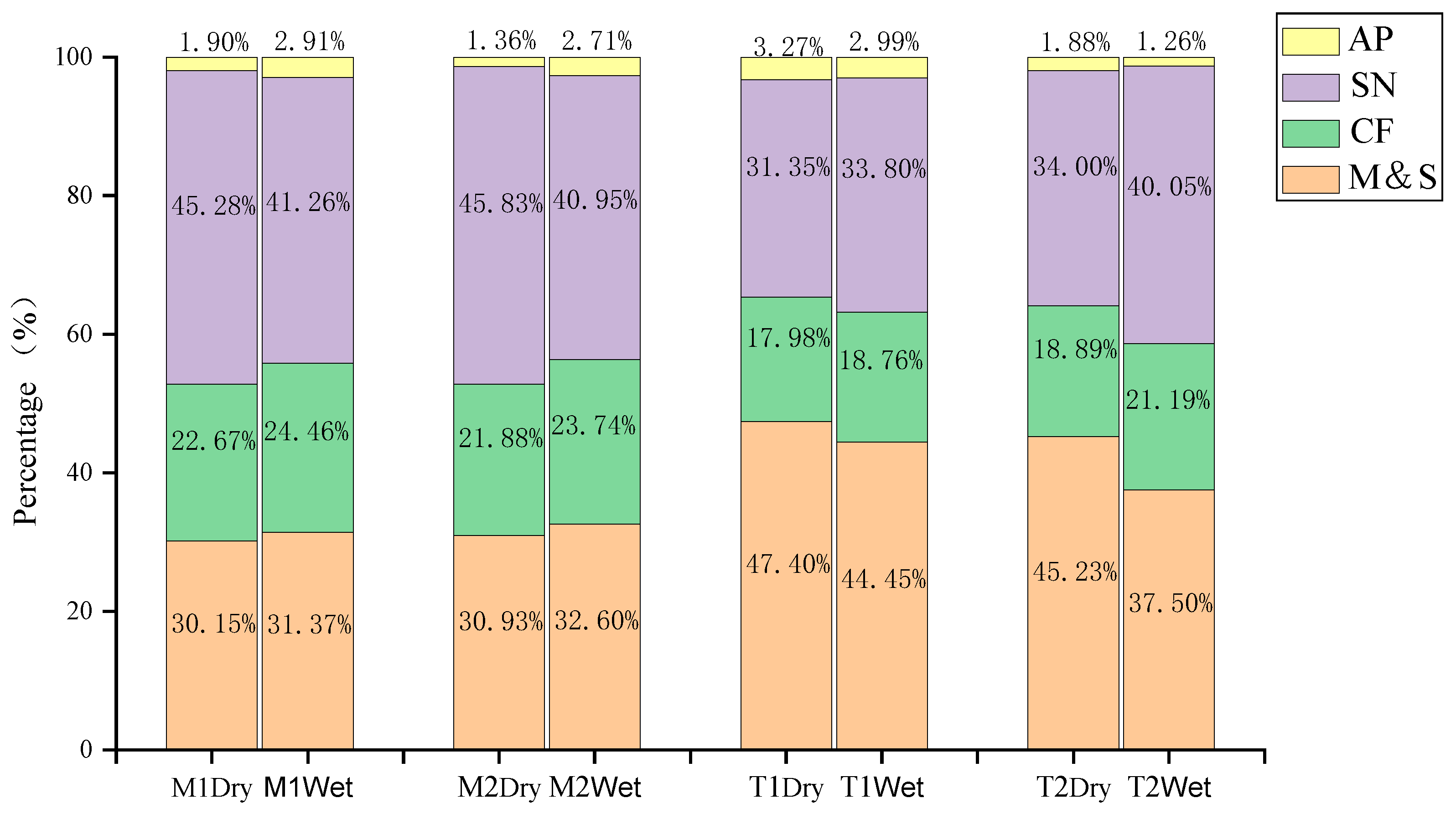Spatio-Temporal Variations in Nitrate Sources and Transformations in the Midstream of the Yellow River Determined Based on Nitrate Isotopes and Hydrochemical Compositions
Abstract
:1. Introduction
2. Materials and Methods
2.1. Study Area
2.2. Sample Collection and Analysis Methods
2.3. SIAR Program Based on Bayesian Isotope Mixing Model
2.4. The Source of the Referenced Data
3. Results
3.1. Temporal and Spatial Variations of Hydrochemical Parameters
3.2. Spatial and Temporal Variations in δ15N-NO3− and δ18O-NO3−
4. Discussion
4.1. Analysis of the Sources of Nitrate
4.2. Analysis of the Transformation Pathways of Nitrogen Pollutants
5. Conclusions
Author Contributions
Funding
Data Availability Statement
Conflicts of Interest
References
- Hameed, A.; Nazir, S.; Rehman, J.U.; Ahmad, N.; Hussain, A.; Alam, I.; Nazir, A.; Tahir, M. Assessment of health hazards related to contaminations of fluorides, nitrates, and nitrites in drinking water of Vehari, Punjab, Pakistan. Hum. Ecol. Risk Assess. Int. J. 2020, 27, 1509–1522. [Google Scholar] [CrossRef]
- Zhang, X.; Zhang, Y.; Shi, P.; Bi, Z.; Shan, Z.; Ren, L. The deep challenge of nitrate pollution in river water of China. Sci. Total Environ. 2021, 770, 144674. [Google Scholar] [CrossRef] [PubMed]
- Yue, F.; Li, S.; Liu, C.; Zhao, Z.; Ding, H. Tracing nitrate sources with dual isotopes and long term monitoring of nitrogen species in the Yellow River, China. Sci. Rep. 2017, 7, 8537. [Google Scholar] [CrossRef] [PubMed]
- Carrey, R.; Ballesté, E.; Blanch, A.R.; Lucena, F.; Pons, P.; López, J.M.; Rull, M.; Solà, J.; Micola, N.; Fraile, J.; et al. Combining multi-isotopic and molecular source tracking methods to identify nitrate pollution sources in surface and groundwater. Water Research 2021, 188, 116537. [Google Scholar] [CrossRef] [PubMed]
- Kasem, A.M.; Xu, Z.; Jiang, H.; Liu, W.; Zhang, J.; Nosair, A.M. Nitrate Source and Transformation in Groundwater under Urban and Agricultural Arid Environment in the Southeastern Nile Delta, Egypt. Water 2023, 16, 22. [Google Scholar] [CrossRef]
- Yin, C.; Yang, H.; Wang, J.; Guo, J.; Tang, X.; Chen, J. Combined use of stable nitrogen and oxygen isotopes to constrain the nitrate sources in a karst lake. Agric. Ecosyst. Environ. 2020, 303, 107089. [Google Scholar] [CrossRef]
- Zhao, Y.; Dang, J.; Wang, F. Sources of Nitrogen Pollution in Upstream of Fenhe River Reservoir Based on the Nitrogen and Oxygen Stable Isotope. J. Chem. 2020, 2020, 1–8. [Google Scholar] [CrossRef]
- Guo, W.; Luo, L.; Zhang, Z.; Zheng, N.; Xiao, H.; Xiao, H. The use of stable oxygen and nitrogen isotopic signatures to reveal variations in the nitrate formation pathways and sources in different seasons and regions in China. Environ. Res. 2021, 201, 111537. [Google Scholar] [CrossRef]
- Xue, D.; Botte, J.; De Baets, B.; Accoe, F.; Nestler, A.; Taylor, P.; Van Cleemput, O.; Berglund, M.; Boeckx, P. Present limitations and future prospects of stable isotope methods for nitrate source identification in surface and groundwater. Water Res. 2009, 43, 1159–1170. [Google Scholar] [CrossRef]
- Xia, X.; Zhang, S.; Li, S.; Zhang, L.; Wang, G.; Zhang, L.; Wang, J.; Li, Z. The cycle of nitrogen in river systems: Sources, transformation, and flux. Environ. Sci. Process. Impacts 2018, 20, 863–891. [Google Scholar] [CrossRef]
- Xue, D.; De Baets, B.; Van Cleemput, O.; Hennessy, C.; Berglund, M.; Boeckx, P. Use of a Bayesian isotope mixing model to estimate proportional contributions of multiple nitrate sources in surface water. Environ. Pollut. 2012, 161, 43–49. [Google Scholar] [CrossRef] [PubMed]
- Zhang, J.; Cao, M.; Jin, M.; Huang, X.; Zhang, Z.; Kang, F. Identifying the source and transformation of riverine nitrates in a karst watershed, North China: Comprehensive use of major ions, multiple isotopes and a Bayesian model. J. Contam. Hydrol. 2022, 246, 103957. [Google Scholar] [CrossRef] [PubMed]
- Xing, M.; Liu, W. Using dual isotopes to identify sources and transformations of nitrogen in water catchments with different land uses, Loess Plateau of China. Environ. Sci. Pollut. Res. 2015, 23, 388–401. [Google Scholar] [CrossRef] [PubMed]
- Zhang, Y.; Shi, P.; Li, F.; Wei, A.; Song, J.; Ma, J. Quantification of nitrate sources and fates in rivers in an irrigated agricultural area using environmental isotopes and a Bayesian isotope mixing model. Chemosphere 2018, 208, 493–501. [Google Scholar] [CrossRef] [PubMed]
- Li, C.; Li, S.; Yue, F.; Liu, J.; Zhong, J.; Yan, Z.; Zhang, R.; Wang, Z.; Xu, S. Identification of sources and transformations of nitrate in the Xijiang River using nitrate isotopes and Bayesian model. Sci. Total Environ. 2019, 646, 801–810. [Google Scholar] [CrossRef] [PubMed]
- Liu, X.; Han, G.; Zeng, J.; Liu, J.; Li, X.; Boeckx, P. The effects of clean energy production and urbanization on sources and transformation processes of nitrate in a subtropical river system: Insights from the dual isotopes of nitrate and Bayesian model. J. Clean. Prod. 2021, 325, 129317. [Google Scholar] [CrossRef]
- Chen, W.; Zhang, X.; Wu, N.; Yuan, C.; Liu, Y.; Yang, Y.; Chen, Z.; Dahlgren, R.A.; Zhang, M.; Ji, X. Sources and transformations of riverine nitrogen across a coastal-plain river network of eastern China: New insights from multiple stable isotopes. Sci. Total Environ. 2024, 924, 171671. [Google Scholar] [CrossRef] [PubMed]
- Fadhullah, W.; Yaccob, N.S.; Syakir, M.I.; Muhammad, S.A.; Yue, F.; Li, S. Nitrate sources and processes in the surface water of a tropical reservoir by stable isotopes and mixing model. Sci. Total Environ. 2020, 700, 134517. [Google Scholar] [CrossRef] [PubMed]
- Hu, Y.; Jin, Z.; Hu, Q.; Hu, J.; Ni, C.; Li, F. Using stable isotopes to identify nitrogen transformations and estimate denitrification in a semi-constructed wetland. Sci. Total Environ. 2020, 720, 137628. [Google Scholar] [CrossRef]
- Battaglin, W.A.; Kendall, C.; Chang, C.C.Y.; Silva, S.R.; Campbell, D.H. Chemical and isotopic evidence of nitrogen transformation in the Mississippi River, 1997–1998. Hydrol. Process. 2001, 15, 1285–1300. [Google Scholar] [CrossRef]
- Liu, T.; Wang, F.; Michalski, G.; Xia, X.; Liu, S. Using 15N, 17O, and 18O To Determine Nitrate Sources in the Yellow River, China. Environ. Sci. Technol. 2013, 47, 13412–13421. [Google Scholar] [CrossRef] [PubMed]
- Dong, Y.; Yang, J.; Zhao, X.; Yang, S.; Mulder, J.; Dörsch, P.; Zhang, G. Nitrate runoff loss and source apportionment in a typical subtropical agricultural watershed. Environ. Sci. Pollut. Res. 2021, 29, 20186–20199. [Google Scholar] [CrossRef] [PubMed]
- Wu, Y.; Jiang, X.; Yao, Y.; Kang, X.; Niu, Y.; Wang, K. Effect of rainfall–runoff process on sources and transformation of nitrate at the urban catchment scale. Urban Clim. 2024, 53, 101805. [Google Scholar] [CrossRef]
- Wu, Y.; Ju, H.; Jiang, H.; Zhang, G.; Qi, P.; Li, Z. Identifying nitrate sources and transformations in an agricultural watershed in Northeast China: Insights from multiple isotopes. J. Environ. Manag. 2023, 340, 118023. [Google Scholar] [CrossRef]
- Sui, Y.; Ou, Y.; Yan, B.; Rousseau, A.N.; Fang, Y.; Geng, R.; Wang, L.; Ye, N. A dual isotopic framework for identifying nitrate sources in surface runoff in a small agricultural watershed, northeast China. J. Clean. Prod. 2020, 246, 119074. [Google Scholar] [CrossRef]
- Weigand, M.A.; Foriel, J.; Barnett, B.; Oleynik, S.; Sigman, D.M. Updates to instrumentation and protocols for isotopic analysis of nitrate by the denitrifier method. Rapid Commun. Mass Spectrom. 2016, 30, 1365–1383. [Google Scholar] [CrossRef] [PubMed]
- Fu, Q.; Zhang, W.P. Practical Handbook of Environmental Monitoring Standards (Book 1): Water Monitoring Methods; China Environmental Sciences Press: Beijing, China, 2013. [Google Scholar]
- Cui, J.; Zhou, F.; Gao, M.; Zhang, L.; Zhang, L.; Du, K.; Leng, Q.; Zhang, Y.; He, D.; Yang, F.; et al. A comparison of various approaches used in source apportionments for precipitation nitrogen in a mountain region of southwest China. Environ. Pollut. 2018, 241, 810–820. [Google Scholar] [CrossRef] [PubMed]
- Salmasi, F.; Abraham, J.; Salmasi, A. Effect of stepped spillways on increasing dissolved oxygen in water, an experimental study. J. Environ. Manag. 2021, 299, 113600. [Google Scholar] [CrossRef]
- Xia, X.; Liu, T.; Yang, Z.; Michalski, G.; Liu, S.; Jia, Z.; Zhang, S. Enhanced nitrogen loss from rivers through coupled nitrification-denitrification caused by suspended sediment. Total Environ. 2017, 579, 47–59. [Google Scholar] [CrossRef]
- Liu, T.; Xia, X.; Liu, S.; Mou, X.; Qiu, Y. Acceleration of denitrification in turbid rivers due to denitrification occurring on suspended sediment in oxic waters. Environ. Sci. Technol. 2013, 47, 4053–4061. [Google Scholar] [CrossRef]
- Li, Y.; Guo, L.; Shi, T.; Gavin, S.; Zhao, H. Salinity of animal manure and potential risk of secondary soil salinization through successive manure application. Sci. Total Environ. 2007, 383, 106–114. [Google Scholar]
- Liu, C.; Li, S.; Lang, Y. Using δ15N and δ18O Values To Identify Nitrate Sources in Karst Ground Water, Guiyang, Southwest China. Environ. Sci. Technol. 2006, 40, 6928–6933. [Google Scholar] [CrossRef] [PubMed]
- Widory, D.; Petelet, G.; Negrel, P.; Ladouche, B. Tracking the sources of nitrate in groundwater using coupled nitrogen and boron isotopes a synthesis. Environ. Sci. Technol. 2005, 39, 539–548. [Google Scholar] [CrossRef] [PubMed]
- Li, Y.; Yang, Z.; Yin, X.; Sun, W. Identification of nitrate sources and the fate of nitrate in downstream areas: A case study in the Taizi River Basin. Environ. Sci. 2018, 39, 1076–1084. [Google Scholar]
- Zhang, Y.; Shi, P.; Song, J.; Li, Q. Application of Nitrogen and Oxygen Isotopes for Source and Fate Identification of Nitrate Pollution in Surface Water: A Review. Appl. Sci. 2018, 9, 18. [Google Scholar] [CrossRef]
- Qin, Y.; Zhang, D.; Wang, F. Using nitrogen and oxygen isotopes to access sources and transformations of nitrogen in the Qinhe Basin, North China. Environ. Sci. Pollut. Res. 2018, 26, 738–748. [Google Scholar] [CrossRef]
- Chen, Z.; Yu, L.; Liu, W.; Lam, M.; Liu, G.; Yin, X. Nitrogen and oxygen isotopic compositions of water-soluble nitrate in Taihu Lake water system, China: Implication for nitrate sources and biogeochemical process. Environ. Earth Sci. 2013, 71, 217–223. [Google Scholar] [CrossRef]
- Alexander, R.B.; Smith, R.A.; Schwarz, G.E. Effect of stream channel size on the delivery of nitrogen to the Gulf of Mexico. Nature 2000, 403, 758–761. [Google Scholar] [CrossRef]





| Location | Time | Statistic | pH | T | DO | CODcr | NH4+ | NO3− | TN | Cl− | SS |
|---|---|---|---|---|---|---|---|---|---|---|---|
| M1 | Dry season | Max | 8.40 | 12.10 | 13.20 | 16.12 | 0.22 | 3.87 | 4.57 | 116.13 | 1439.65 |
| Min | 7.90 | 3.80 | 10.00 | 10.30 | 0.04 | 2.69 | 3.23 | 107.11 | 571.55 | ||
| Mean | 8.26 | 8.22 | 11.36 | 12.49 | 0.15 | 3.21 | 3.87 | 111.61 | 1040.81 | ||
| SD | 0.22 | 3.44 | 1.34 | 2.33 | 0.07 | 0.43 | 0.52 | 3.53 | 349.17 | ||
| Wet season | Max | 8.10 | 29.90 | 8.40 | 15.10 | 0.22 | 2.96 | 3.62 | 118.78 | 2369.22 | |
| Min | 7.70 | 22.70 | 6.90 | 11.80 | 0.03 | 1.44 | 1.93 | 102.33 | 1372.26 | ||
| Mean | 7.90 | 25.70 | 7.72 | 13.82 | 0.09 | 2.19 | 2.67 | 109.28 | 1861.44 | ||
| SD | 0.15 | 2.88 | 0.57 | 1.27 | 0.08 | 0.66 | 0.73 | 8.34 | 422.26 | ||
| M2 | Dry season | Max | 8.60 | 12.30 | 12.80 | 17.34 | 0.21 | 3.74 | 4.67 | 118.17 | 1198.87 |
| Min | 7.80 | 4.20 | 9.60 | 10.50 | 0.09 | 2.65 | 3.17 | 106.34 | 632.09 | ||
| Mean | 8.32 | 8.58 | 10.76 | 12.79 | 0.16 | 3.34 | 4.04 | 113.20 | 907.01 | ||
| SD | 0.30 | 3.45 | 1.32 | 2.68 | 0.05 | 0.42 | 0.58 | 4.81 | 261.99 | ||
| Wet season | Max | 8.10 | 30.10 | 8.20 | 14.90 | 0.34 | 3.06 | 3.80 | 116.87 | 1839.16 | |
| Min | 7.70 | 22.80 | 6.70 | 11.80 | 0.02 | 1.37 | 1.88 | 104.23 | 1089.23 | ||
| Mean | 7.90 | 25.86 | 7.36 | 13.57 | 0.14 | 2.33 | 2.89 | 109.52 | 1462.57 | ||
| SD | 0.15 | 3.01 | 0.67 | 1.31 | 0.12 | 0.71 | 0.79 | 5.98 | 314.45 | ||
| T1 | Dry season | Max | 8.30 | 13.10 | 16.40 | 31.30 | 0.79 | 6.12 | 7.42 | 79.04 | 60.11 |
| Min | 7.60 | 4.00 | 8.90 | 10.90 | 0.52 | 3.98 | 5.46 | 71.00 | 43.28 | ||
| Mean | 8.04 | 9.14 | 11.80 | 15.77 | 0.67 | 4.78 | 6.16 | 73.24 | 51.23 | ||
| SD | 0.26 | 4.01 | 2.94 | 8.78 | 0.10 | 0.83 | 0.82 | 3.27 | 6.31 | ||
| Wet season | Max | 8.40 | 29.20 | 12.50 | 24.30 | 0.77 | 3.38 | 4.46 | 60.44 | 74.15 | |
| Min | 7.90 | 25.50 | 7.70 | 12.60 | 0.10 | 1.31 | 1.46 | 52.08 | 57.11 | ||
| Mean | 8.18 | 28.18 | 9.46 | 18.60 | 0.57 | 2.02 | 2.93 | 56.37 | 65.20 | ||
| SD | 0.21 | 1.52 | 2.13 | 5.35 | 0.27 | 0.82 | 1.08 | 3.10 | 6.83 | ||
| T2 | Dry season | Max | 8.60 | 13.30 | 14.60 | 9.23 | 0.21 | 4.81 | 6.21 | 77.00 | 70.92 |
| Min | 8.10 | 4.10 | 7.60 | 8.21 | 0.11 | 4.02 | 4.48 | 61.00 | 48.16 | ||
| Mean | 8.35 | 9.16 | 10.66 | 8.65 | 0.16 | 4.41 | 5.48 | 66.64 | 56.64 | ||
| SD | 0.18 | 3.98 | 2.53 | 0.46 | 0.05 | 0.28 | 0.67 | 6.55 | 8.84 | ||
| Wet season | Max | 8.70 | 28.60 | 9.20 | 11.60 | 0.21 | 4.02 | 4.70 | 55.70 | 113.04 | |
| Min | 7.90 | 25.80 | 7.20 | 8.15 | 0.05 | 1.55 | 1.65 | 41.27 | 63.54 | ||
| Mean | 8.51 | 27.30 | 8.24 | 10.39 | 0.16 | 3.13 | 3.97 | 49.81 | 92.95 | ||
| SD | 0.31 | 0.99 | 0.73 | 1.41 | 0.07 | 0.94 | 1.30 | 5.32 | 19.48 |
| Location | Correlation Coefficient | |
|---|---|---|
| NH4+-N | TN | |
| M2 | −0.06 | −0.19 |
| T1 | −0.02 | −0.15 |
| T2 | 0.06 | 0.07 |
| Location | Statistic | δ15N-NO3− | δ18O-NO3− | δ15N-NO3− | δ18O-NO3− |
|---|---|---|---|---|---|
| Dry Season | Wet Season | ||||
| M1 | Max | 9.45 | 2.67 | 8.60 | 1.95 |
| Min | 8.22 | 1.86 | 8.43 | −0.14 | |
| Mean | 8.78 | 2.11 | 8.52 | 1.42 | |
| SD | 0.48 | 0.32 | 0.08 | 0.88 | |
| M2 | Max | 10.10 | 3.55 | 9.05 | 4.25 |
| Min | 8.67 | 1.86 | 8.58 | 0.21 | |
| Mean | 9.39 | 2.90 | 8.75 | 2.13 | |
| SD | 0.63 | 0.77 | 0.20 | 1.45 | |
| T1 | Max | 14.75 | 6.54 | 14.82 | 5.91 |
| Min | 13.30 | 5.54 | 11.24 | 5.47 | |
| Mean | 13.77 | 5.91 | 12.20 | 5.70 | |
| SD | 0.57 | 0.39 | 1.48 | 0.16 | |
| T2 | Max | 13.83 | 6.16 | 11.96 | 4.98 |
| Min | 11.98 | 4.25 | 9.91 | 2.91 | |
| Mean | 13.14 | 4.92 | 11.05 | 3.49 | |
| SD | 0.80 | 0.73 | 0.76 | 0.84 | |
Disclaimer/Publisher’s Note: The statements, opinions and data contained in all publications are solely those of the individual author(s) and contributor(s) and not of MDPI and/or the editor(s). MDPI and/or the editor(s) disclaim responsibility for any injury to people or property resulting from any ideas, methods, instructions or products referred to in the content. |
© 2024 by the authors. Licensee MDPI, Basel, Switzerland. This article is an open access article distributed under the terms and conditions of the Creative Commons Attribution (CC BY) license (https://creativecommons.org/licenses/by/4.0/).
Share and Cite
Su, C.; Su, Y.; Zhang, R.; Xu, X.; Li, J. Spatio-Temporal Variations in Nitrate Sources and Transformations in the Midstream of the Yellow River Determined Based on Nitrate Isotopes and Hydrochemical Compositions. Water 2024, 16, 1173. https://doi.org/10.3390/w16081173
Su C, Su Y, Zhang R, Xu X, Li J. Spatio-Temporal Variations in Nitrate Sources and Transformations in the Midstream of the Yellow River Determined Based on Nitrate Isotopes and Hydrochemical Compositions. Water. 2024; 16(8):1173. https://doi.org/10.3390/w16081173
Chicago/Turabian StyleSu, Caili, Yuxuan Su, Rongkai Zhang, Xiaohang Xu, and Junhua Li. 2024. "Spatio-Temporal Variations in Nitrate Sources and Transformations in the Midstream of the Yellow River Determined Based on Nitrate Isotopes and Hydrochemical Compositions" Water 16, no. 8: 1173. https://doi.org/10.3390/w16081173
APA StyleSu, C., Su, Y., Zhang, R., Xu, X., & Li, J. (2024). Spatio-Temporal Variations in Nitrate Sources and Transformations in the Midstream of the Yellow River Determined Based on Nitrate Isotopes and Hydrochemical Compositions. Water, 16(8), 1173. https://doi.org/10.3390/w16081173






